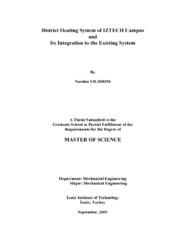Please use this identifier to cite or link to this item:
https://hdl.handle.net/11147/3084| Title: | District Heting System of Iztech Campus and Its Integration To the Existing System | Authors: | Yıldırım, Nurdan | Advisors: | Gökçen Akkurt, Gülden | Publisher: | Izmir Institute of Technology | Abstract: | Izmir Institute of Technology (IZTECH), founded in 1992, is the third state university of Izmir. At present IZTECH Campus has individual fuel boiler heating systems for each faculty building and the Campus is still under development. But the Campus has also a geothermal source. In 2002, 5 gradient wells were drilled. Of these, one well has a geothermal fluid of 33°C is obtained but the actual flowrate of the geothermal fluid has not been measured yet. The aim of this Thesis is to investigate this source whether it can be used for district heating application for IZTECH Campus. Mainly two heating system types have been considered;. Heat pump heating system (HPHS) (using a renewable energy source, geothermal energy), . Fuel boiler heating system (FBHS) (using a conventional energy source, fuel-oil). HPHS is considered as HPO type since the existing geothermal fluid temperature is low. While HPHS is considered only as district, FBHS is considered as district and individual. Each heating system is simulated using hourly outdoor temperature data. For these heating simulations, the main control parameter is the indoor temperature of the buildings. Mathematical models are derived using Matlab [16] and EES [17] programs. Various heating regime alternatives have been studied for HPHS for the various condenser outlet temperature and geothermal fluid flowrate. Consequently, the heating regime with 35°C condenser inlet and 45°C condenser outlet temperature with 120 kg/s geothermal fluid flowrate considered to be the best option. FBHSs are also simulated for various boiler set temperatures. Boiler set emperatures have been recommended by Demirdöküm [39], is the best alternative with the least fuel consumption and best indoor temperature around 20°C. Besides heating system simulations, piping network simulation is made using the software Pipelab [18]. The piping network of the Campus has been considered with two loops as geothermal and Campus. Each loop contains supply and return main. The location of the heat centre and the pressure loss per unit length are common design parameters for economy of the system. Therefore, several alternatives have been studied and because of the lowest investment and operational cost, Alternative 3, where the heat centre is in the middle of the Campus, is considered to be the best option with target pressure loss of 150 Pa/m. For installation type of piping network, underground (buried) pipeline installation is selected. Furthermore, economic analysis has also been done for each heating system alternative depending on investment and operational costs. For operational cost, 3 heating scenarios are considered depending on the heating period of the buildings in the Campus. According to the results of economical analyses, while heat pump district heating system (HPDHS) has the biggest investment cost with 3,040,125 US$, it has minimum operational cost. The alternatives are evaluated according to internal rate of return (IRR) method, which shows the profit of the investment. The results indicate that, the HPDHS has minimum 3.02% profit according to the fuel boiler district heating system (FBDHS) at the end of the 20-year period. The profit increases with increasing operating period of the heating systems. | Description: | Thesis (Master)--Izmir Institute of Technology, Mechanical Engineering, Izmir, 2003 Includes bibliographical references (leaves: 116-119) Text in English; Abstract: Turkish and English xviii, 137 leaves |
URI: | http://hdl.handle.net/11147/3084 |
| Appears in Collections: | Master Degree / Yüksek Lisans Tezleri |
Files in This Item:
| File | Description | Size | Format | |
|---|---|---|---|---|
| T000301.pdf | MasterThesis | 1.19 MB | Adobe PDF |  View/Open |
CORE Recommender
Page view(s)
392
checked on Mar 31, 2025
Download(s)
148
checked on Mar 31, 2025
Google ScholarTM
Check
Items in GCRIS Repository are protected by copyright, with all rights reserved, unless otherwise indicated.